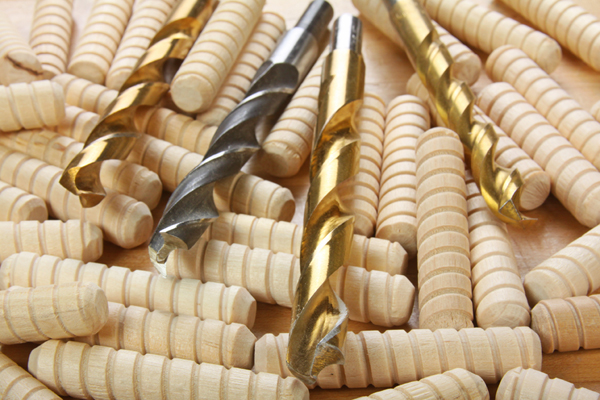
I enjoy both the eZine and the paper copy and thought I’d ask your readers for suggestions on how to accurately drill a 3/32 inch hole in the center of a 5/16 inch dowel. The wood grain causes the drill bit to wander and I need to make 20 cannon barrels 1-1/4 x 5/16 in. (turned to the shape of a naval cannon barrel, of course) for the model of the USS Constitution I’ve been working on for over two years. In addition to the barrels, I have to drill enough dowel material to cut out 80 wheels for the gun carriages. The model is scratch built, about 36 inches in length…talk about miniature woodworking! – Chief Petty Officer Richard Langill, U.S. Navy
Chris Marshall: Pen turners solve the problem of centering holes like this by starting with a larger square blank and drilling the through hole first, then turning away the excess for their pen cylinders with the hole already done. You’re dealing with a more complex situation, since the dowel is curved to begin with and the dimensions are critically small. It’s both a clamping issue and a registration issue on a drill press to achieve that center point. You might want to consider the pen-turning approach here and mill these barrels and wheels on a mini lathe from square stock instead of starting with dowels. It would add steps and tooling to the process, but you’d achieve the exact goal you want in the end, and you’d add some precision spindle-turning skills to your woodworking too.
Tim Inman: Now here’s a question that warms my heart! Why? Its answer is in the very center (pun intended) of the old masters’ skills and ingenuity. Have you ever wondered how the Victorian turners produced a hole in the center of those dramatically long ivory and amber cigarette holders? Or have you wondered how gunsmiths were able to bore holes right down the middle of a gun barrel blank even way back when? The answer is not heavy-duty machinery. It is in both skill and a clever drill bit design. The drill you need is called a “D” drill. It is easily made right in your own shop from a piece of quality tool steel. The diameter of the steel rod is the diameter of the hole you wish to drill. It is called a “D” drill because if you look at the rod from the sharpened end, you will see the letter “D.” To make the drill, grind the rod down to the EXACT center. I usually make my grinding wheel width the length of this grind So, for about 3/4 inch, I grind away until I hit the maximum width of the rod – the center line. Then, turn the rod and grind a slight rake angle on the end, and a slight clearance angle on the underside to form a cutting edge. Presto! You now have a “D” drill. Install it in a nice handle, or even a spare 3-jaw chuck.
To use a “D” drill, typically, the workpiece is turning and the drill is stationary. You carefully feed the drill into the center of the workpiece. When the hole has been widened out to the diameter of the drill, you push the drill right down the middle, and you have the centered hole you want. The “bad” things about “D” drills are: No good chip clearance mechanism. You must repeatedly extract the drill and clean the dross from the “flat” you ground when making the drill. It takes a bit of learning curve – skill building – to get the hang of starting the drill in the center. You can’t be a bully. If you need larger diameter holes, you must step up from a small drill to progressively larger ones as you go to get the final larger hole. So where do you get small drill rod? Machine tool suppliers, of course, have it in drill rod. One of my favorite “scrounging” sources is old pianos. The strings are high quality steel, and they make great little “D” drills….
The old Holtzapffel books discuss these drills. Bill Jones, who passed on last summer, was the unquestionable “dean” of the bone grubbers and ivory and hardwood turners. He was a personal friend of mine. His Notes from the Turning Shop is probably the modern definitive resource for information about the old masters’ skills and tools. If you’re a serious turner, this is a must-learn, must-make assignment. The geometry of the “D” makes the bit return to the exact center of the turning rod every time it goes around. A “D” drill correctly sharpened cannot run off-center.





